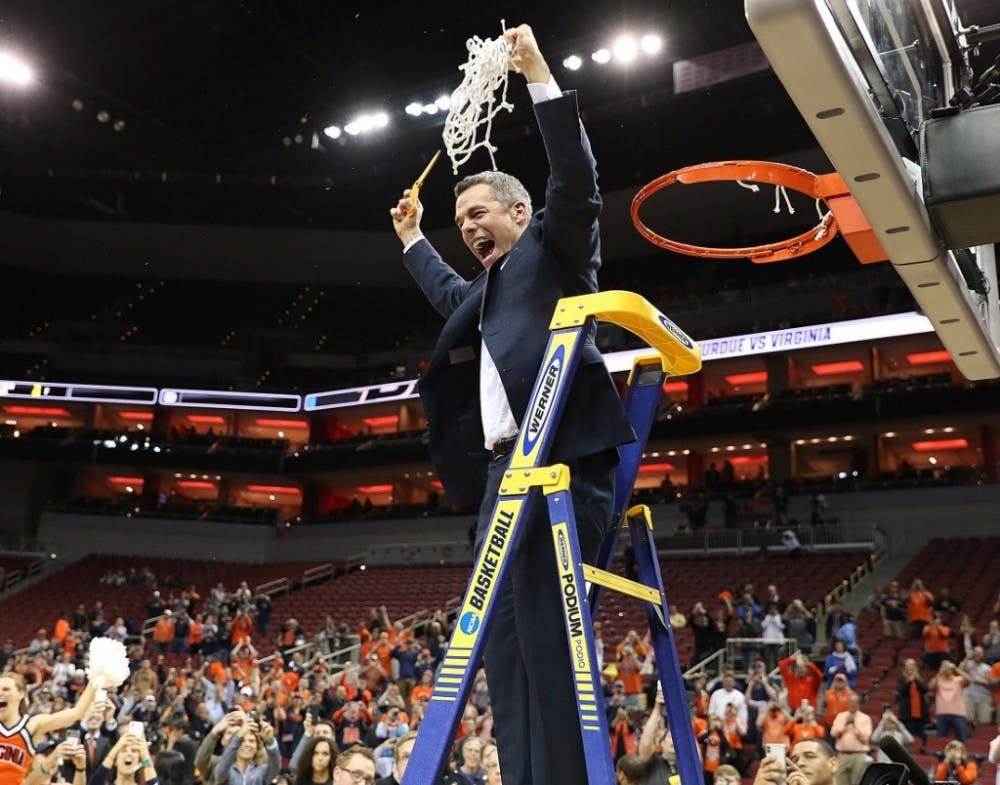I distinctly remember watching the origin game for the “Virginia basketball can’t win in March” moniker.
As a senior in high school who had decided I was going to attend the University of Virginia by mid-March, I intently watched and rooted for the No. 2 seed Cavaliers in the 2015 NCAA Division I Men’s Basketball Tournament. And, unfortunately, I witnessed a truly pitiful effort against No. 7 seed Michigan State — a team Virginia had lost to in March Madness the year before, albeit in a close contest.
In what could have been a moment of sweet revenge, Virginia choked. The Cavaliers held the lead for a grand total of 18 seconds and shot 29.8 percent from the field, including 2-for-17 from downtown. Though the 60-54 final score might indicate a competitive match, every spectator of that game saw the same thing — a bewildered, under-confident team that could not keep pace with the Spartans.
Virginia had a phenomenal season up to that point — the team ranked as high as No. 2 on the AP Poll and remained in the top five for well over two months. On any given night, Anthony Gill, Malcolm Brogdon or Justin Anderson could take over and score 20 or more points. But when it counted most, the Cavaliers could not make the adjustments necessary to win in the playoffs.
History continued to repeat itself. In 2016, the Cavaliers earned a No. 1 seed in the tournament and steamrolled opponents only to let a Final Four berth slip out of their grasp by blowing a 14-point halftime lead to No. 10 seed Syracuse. The following year, an admittedly worse No. 5 seed Virginia was dominated by No. 4 seed Florida, falling 39-65. And nobody can forget –– as much as we may try –– the Cavaliers earning the top overall seed in the tournament last season before subsequently looking like deer caught in headlights against No. 16 seed UMBC.
Heading into this year’s March Madness, media pundits were calling for Virginia’s demise before the NCAA Tournament even kicked off. Following the Cavaliers’ 10-point loss to Florida State in the ACC semifinal, USA TODAY sports columnist Dan Wolken wrote a biting article entitled, “Virginia shows little evidence this March will be different from past failures.” In the article, Wolken noted, “In a tournament where talent transcends the deeper it goes, the burden of proof is on Virginia to show that its defense-first structure still matters when it needs a Plan B.”
Fast forward to Saturday night, in which No. 1 seed Virginia faced off against red-hot No. 3 seed Purdue in the Elite Eight. It’s not hard to imagine that several facets of the game were not part of Virginia’s “Plan A.” Trailing by 10 early on, giving up 42 points to Purdue junior guard Carsen Edwards and having junior guard Kyle Guy miss shot after shot in the first half probably was not what Bennett drew up in the locker room before the game.
Yet, Virginia — still playing defense-first basketball, or at least as best as they could against Edwards, who seemingly could not miss — showed that it could find its Plan B and make the adjustments necessary to win the game. Guy played sensationally in the second half, racking up a game-high 10 rebounds and making five second-half three-pointers to keep pace with the red-hot Edwards. Junior guard Ty Jerome showed no fear, never shying away from taking a pivotal shot. Even sophomore guard De’Andre Hunter, who had an objectively bad game on offense, gave Virginia a clutch go-ahead shot in overtime.
Most crucially, freshman guard Kihei Clark and junior forward Mamadi Diakite — two role players who have grown up before our eyes this tournament — demonstrated something past Virginia teams have lacked: grit. With a laser pass and a quick catch-and-shoot, Clark and Diakite proved that the paralyzed-in-fear Cavalier squad is a relic of the past. Fighting through adversity, Clark, Diakite and the rest of the team proved that they could get it done when it matters most.
This game is simply a microcosm of the new attitude this Virginia team embodies. In a February column, my colleague Zach Zamoff argued that the difference between this year’s squad and those of prior seasons is resilience — not only can this team cause fits for opponents through the pack line defense, but also they “have shown an ability to make comebacks, which will prove to be crucial down the stretch.”
Down seven points with eight minutes to play against then-No. 8 North Carolina on the road? Guy hits a major three that sparks a 7-0 run to tie the game and eventually solidify the victory for Virginia. Trailing a Louisville team that had shot 62.5 percent from downtown by 10 points at halftime? The whole team steps up on defense and holds the Cardinals to 15 second-half points while Hunter takes over on offense. Behind 14 points to No. 16 seed Gardner-Webb in the first round of the NCAA Tournament while trying to shake off the skeleton of last year’s loss? The Cavaliers calm down, remember why they are a No. 1 seed, make a flurry of shots and slow down their opponent en route to a 15-point victory.
By defeating Purdue in a calm, resilient and gritty fashion, Virginia has changed the narrative. The Hoos certainly can come back from tough spots, as they have all season. They definitely can make clutch plays under pressure.
The team did both en route to its first Final Four appearance since 1984.
Virginia basketball can win in March.
Ben Tobin is a Sports Columnist and was the Managing Editor for the 129th term of The Cavalier Daily. He can be reached at benjaminjtobin@gmail.com and on Twitter at @TobinBen.





